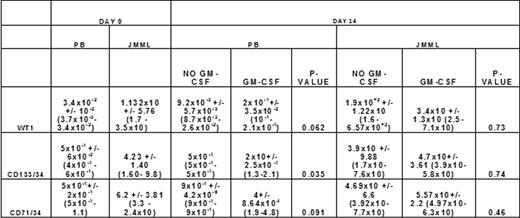Abstract
Abstract 5063
JMML is a rare disease of early childhood, frequently associated with high white cell count with increased monocytes in peripheral blood and splenomegaly. WT1 gene expression is high in most acute and chronic leukemia, including JMML. We have considered WT1 gene expression as a surrogate marker for proliferation. However, there are few reports which suggest that WT1 gene expression contributes to the pathogenesis and prognosis of JMML. In this study we correlate the WT1 gene expression in samples from patients with JMML to establish a direct association of its expression with other markers of proliferation (CD133/CD34 and CD71/34). Samples obtained from 5 newly diagnosed patients with JMML were compared to samples of peripheral blood (PB) obtained from healthy donors (n=3) each sample was placed in liquid culture with or without the addition of GM-CSF at D-0. Cultures were assessed for WT1 gene expression (q-RT-PCR) and flow cytometry at D+7 and D+14, data only presented for D+14. q-RT-PCR: Total RNA was extracted using QIAmp RNA Blood mini kit following manufacture's procedure. A 2-step reverse transcriptase reaction was conducted in a 20 ul reaction volume containing 1ug of total RNA from each sample. Reverse transcription was incubated at 42 degrees C for 1 hour, followed by denaturation at 96 degrees C for 10 min. Ten micro liter of cDNA was amplified during first round of PCR, the second round was carried out by taking 1 ul of the 1st round of amplified product using SyberGreen. After the completion of PCR, the LightCycler Software through extrapolation from the external curve calculated the concentration of target molecule. Flow cytometry: Staining with phenotype markers known to express in early hematopoietic stem cells and proliferation were paired with monoclonal antibodies: CD133/CD34 and CD71/CD34. All determinations were performed in triplicate. Statistical analysis was performed by column statistics and the comparison between groups was done by parametric student t test (Graph Pad by PRISM). The WT1 gene expression was no different at day 14 between the non-GM-CSF and the GM-CSF (see table). WT1 gene expression and early proliferative markers where high in all samples of JMML patients, both in the non-GM-CSF and in the GM-CSF stimulated conditions when compared to the normal controls but, not as high as the K562 cell line. In JMML samples at D+14 there is a 2 fold rise in WT1 gene expression, 12 fold rise in CD 133/34 and a 6 fold rise in CD 71/34. Our findings suggest no difference in WT1 gene expression in JMML cells, and that GM-CSF does not induce higher proliferation of these cells in liquid culture. Thus, our study supports the hypothesis that WT1 gene expression is a surrogate marker of proliferation and may not have any role in the pathogenesis of JMML. GM-CSF does not play a role in the WT1 gene expression. Thus, allowing us to use it as a marker of Minimal Residual Disease (MRD) and its persistence correlate with poor prognosis.
No relevant conflicts of interest to declare.
Author notes
Asterisk with author names denotes non-ASH members.


This feature is available to Subscribers Only
Sign In or Create an Account Close Modal